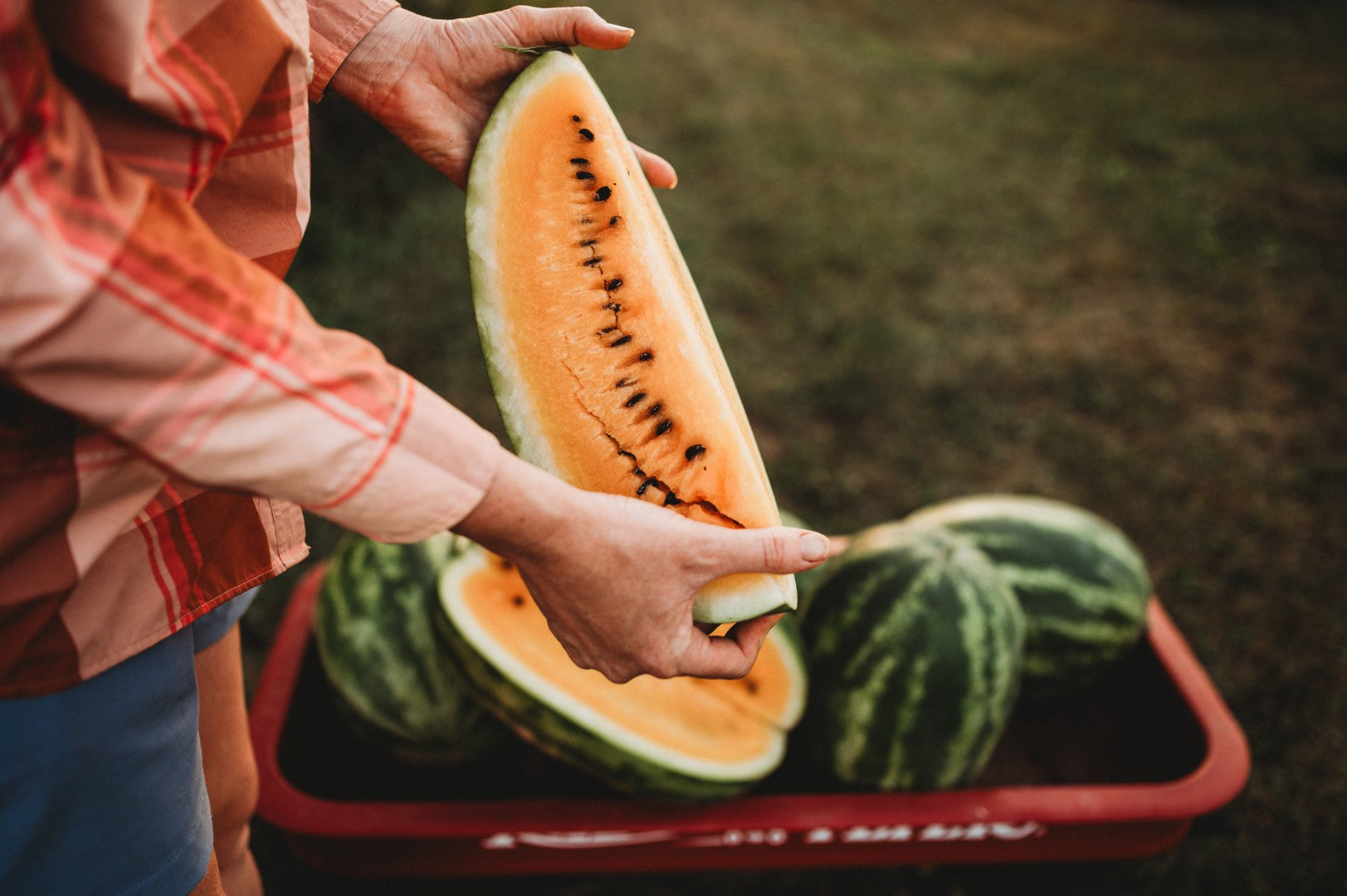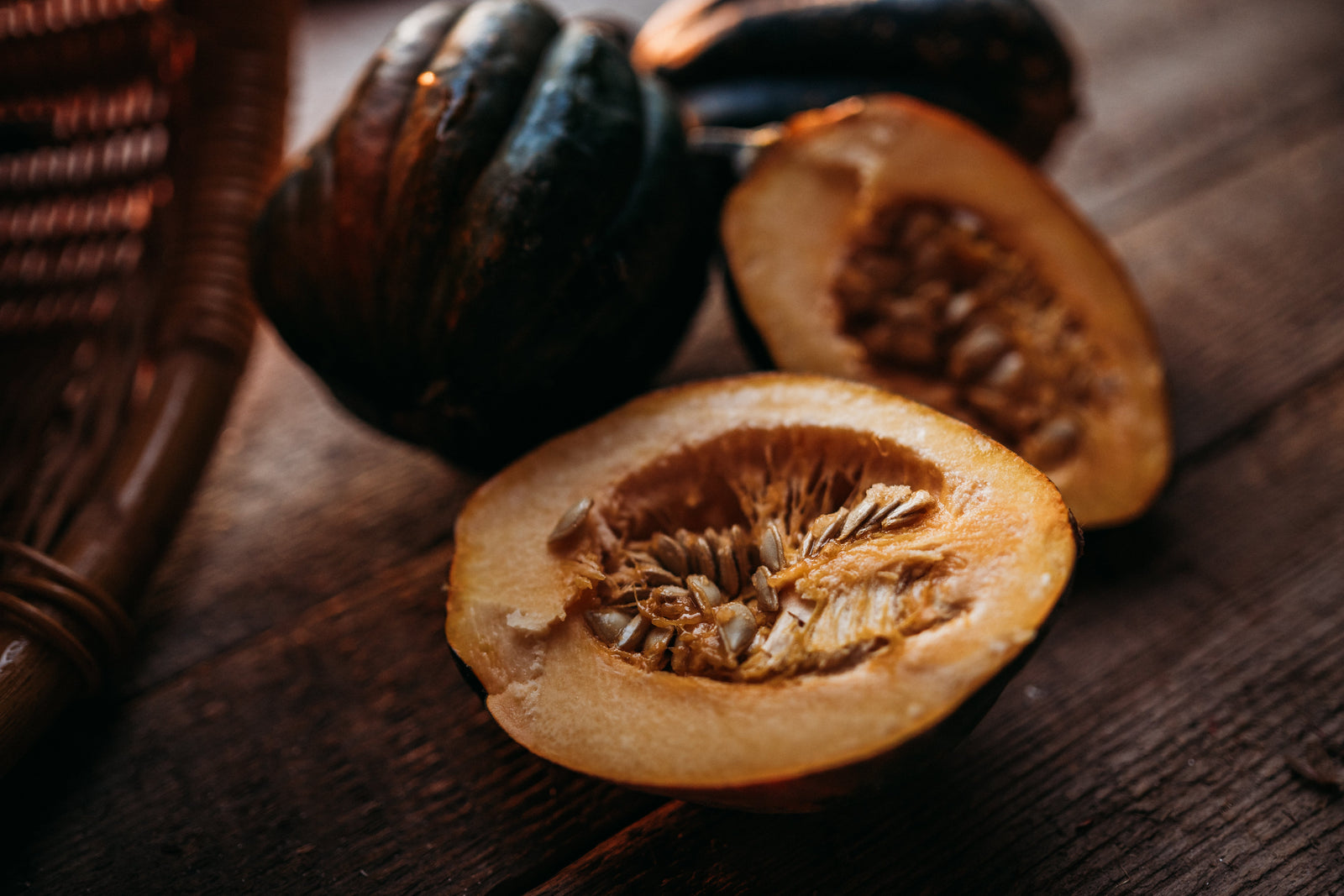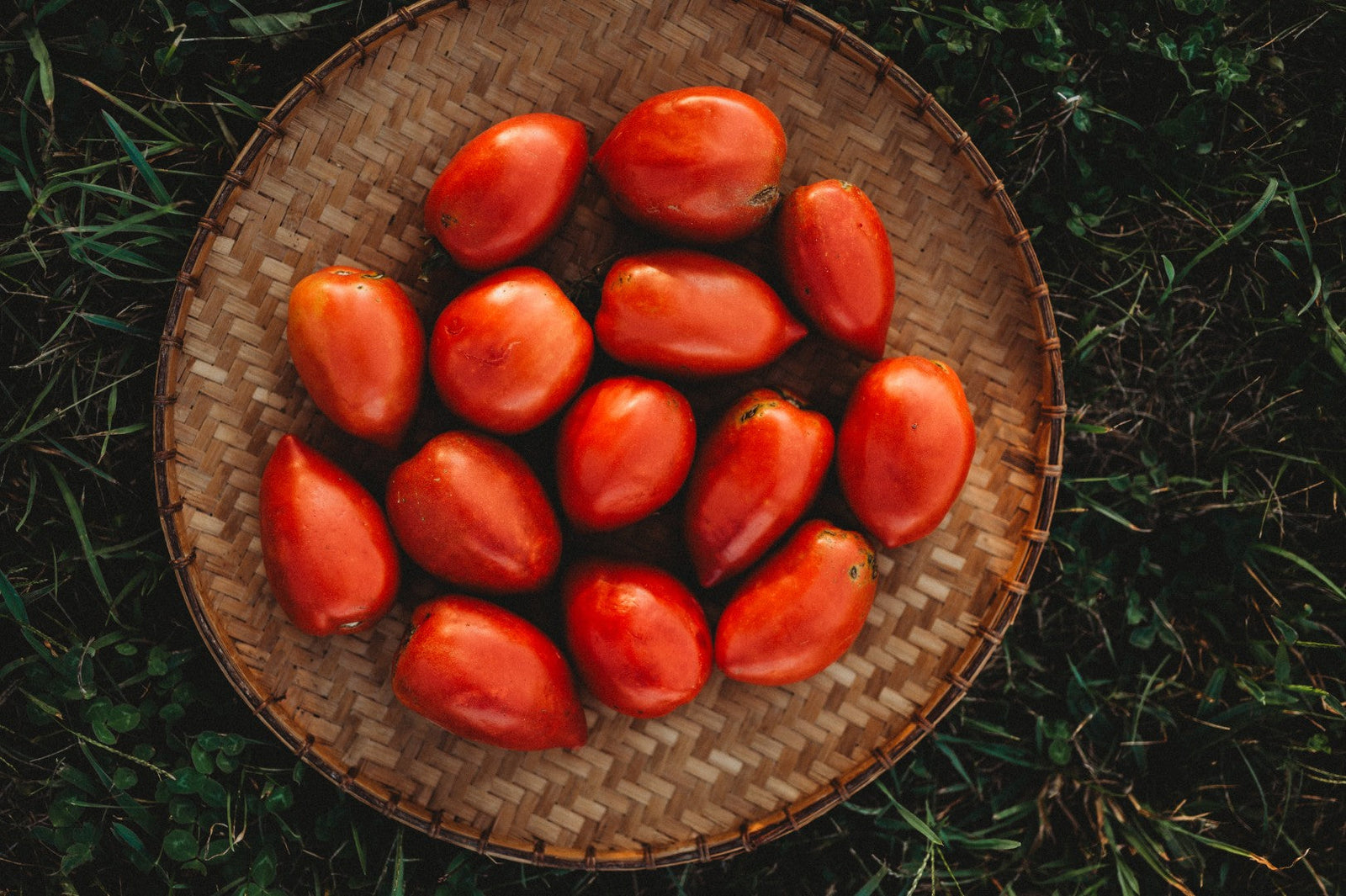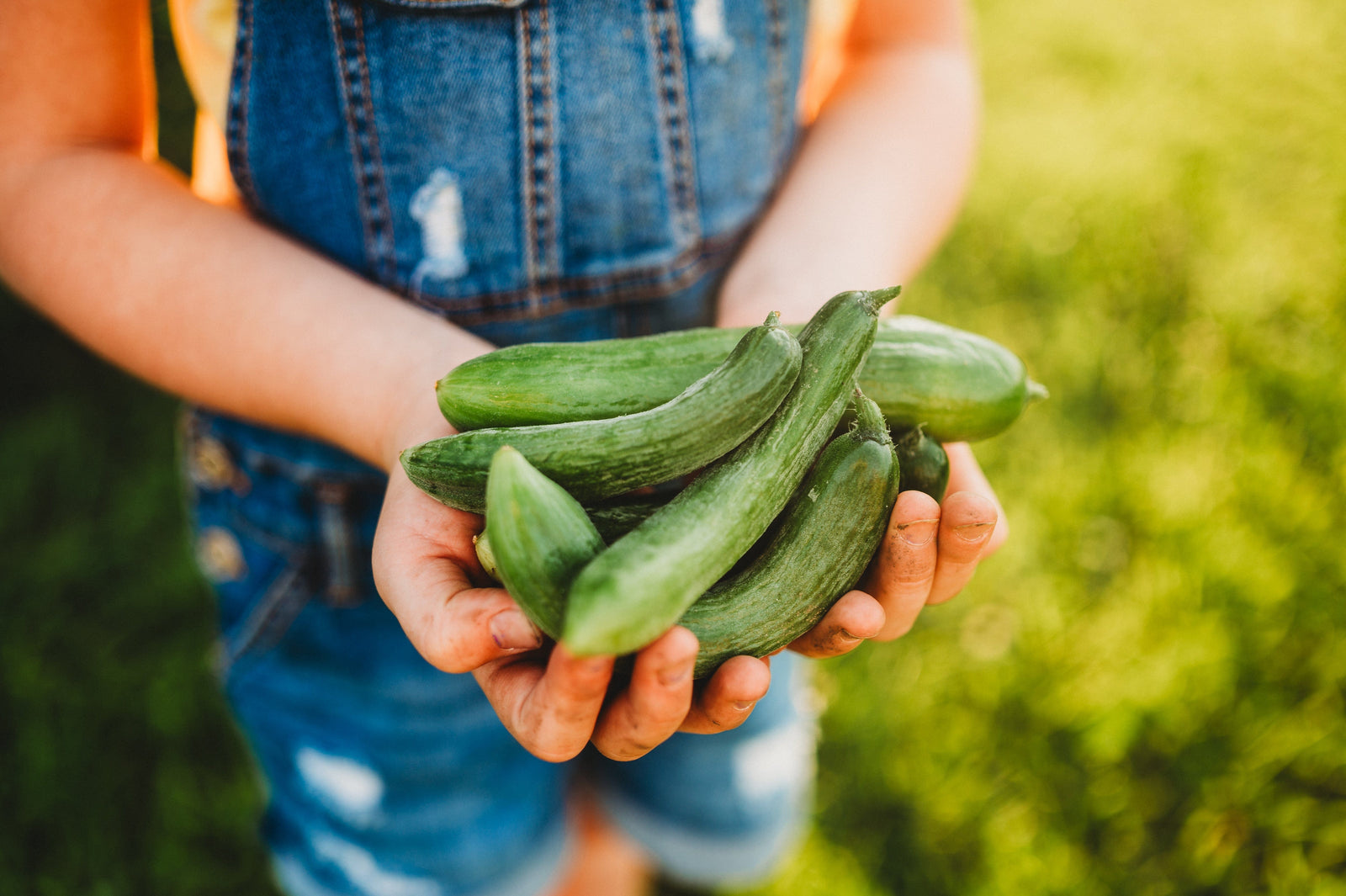Red watermelons may get all the love, but there's a new watermelon on the block. Err. Actually, it's the old watermelon on the block—we'll get to that later. Anyway, let's just say that orange watermelons have staged a comeback and, in this article, we're going to discuss where they came from, what makes them unique, and everything else you've ever wanted to know about growing (and eating) these unique melons. So grab a napkin, maybe a shirt you don’t mind staining, and let’s dig in—it’s about to get juicy.
The (Very Colorful) History of Watermelon
You might be surprised to learn that orange watermelons aren't a modern invention—or some strange result of laboratory tinkering. In fact, the watermelon’s ancestral flesh wasn’t red at all. It was yellowish, sometimes bordering on orange.
Wild watermelons (Citrullus lanatus subsp. cordophanus), native to northeastern Africa, were cultivated for their water content long before anyone cared how sweet they tasted. Early domesticated varieties in Egypt and Sudan were likely pale green, yellow, or orange inside—certainly not the juicy red we know today. One ancient Egyptian tomb painting even depicts a striped, oblong melon with vivid orange flesh—clear evidence that orange-fleshed watermelons were prized thousands of years ago. A 10th-century Persian medical text describes watermelons with yellow pulp, and early European botanical illustrations show a rainbow of rind and flesh colors.

A 17th century painting by Giovanni Stanchi depicts a watermelon with pale flesh. Christies
So how did red become the star? In a word: appeal. As watermelons were bred for flavor, deeper pigments like red became shorthand for ripeness and sweetness. Farmers and consumers alike favored fruits that looked ripe and tasted sweet—leading breeders to select both traits side by side. Over time, pale-fleshed varieties were edged out by the red-fleshed types that dominated the market.
But fast-forward to today, and orange watermelons are making a splash again—this time as heirloom treasures with incredible flavor and undeniable novelty. Gardeners are rediscovering what our ancestors once prized: that watermelon doesn’t need to be red to be delicious.
Why Are Some Watermelons Orange?
With supermarket shelves long ruled by uniform red flesh, it’s no wonder that orange watermelons raise eyebrows. Many consumers assume their unusual color must be the result of genetic modification—but in truth, orange watermelons are simply a product of natural variation and old-fashioned selection.

The color of a watermelon’s flesh comes down to naturally occurring plant pigments called carotenoids. These phytochemicals are responsible for the full spectrum of watermelon colors, from snowy white to deep red.
Red watermelons get their color from lycopene, the same antioxidant found in tomatoes.
Orange watermelons are rich in β-carotene, which also gives carrots their classic orange hue. Other contributors to orange color include ζ-carotene and prolycopene.
Yellow varieties typically contain pigments like violaxanthin and neoxanthin.
White-fleshed watermelons have only trace amounts of carotenoids, including the colorless phytofluene and light yellow ζ-carotene, resulting in their pale appearance.
Behind the scenes, a complex network of genes controls how these pigments are produced, stored, and broken down. Some genes boost carotenoid production, while others regulate their conversion into different compounds.

So orange-meated watermelons aren’t the result of genetic modification—they come from natural mutations that influence how carotenoids are expressed. Over generations, farmers and breeders have selected for these traits, amplifying nature’s variation into the stunning array of flesh colors we see today. Orange watermelons are simply one delicious result of this ongoing relationship between plant genetics and human curiosity.
Orange Watermelon Taste: What to Expect
If you’ve never tried an orange watermelon, you’re in for a treat. While red watermelons are known for their classic, punchy sweetness, orange-fleshed varieties often offer a more mellow, tropical flavor—still sweet, but with a smoother finish and subtle floral or honey-like notes.
Many gardeners describe them as tasting less acidic than red types, making them especially refreshing. Some compare the flavor to cantaloupe or mango, though still unmistakably watermelon. The texture can vary by variety but is typically crisp and juicy, perfect for slicing into wedges or cubing for salads.

Why Do Orange Watermelons Taste Different?
The distinctive flavor of orange-fleshed watermelons isn’t just a trick of the eye—it’s rooted in chemistry. Unlike red types, which often contain higher levels of citric and malic acid (and thus taste sharper or more tangy), orange varieties tend to have lower acidity, resulting in a milder, smoother sweetness.
Their pigments also play a surprising role. Compounds like β-carotene and ζ-carotene, which give the flesh its golden color, can break down into aromatic volatiles that smell and taste floral, fruity, or even tropical. These include compounds like β-ionone and geranyl acetone, which are also found in mangoes and melons. That’s why many tasters report hints of honey, cantaloupe, or mango in orange watermelon—flavor notes that go far beyond simple sugar content.
Recommended Orange-Fleshed Varieties
Hints of mango and honey—have we convinced you yet? If you’re ready to experience orange watermelon for yourself, here are five standout varieties worth growing. Each one brings something unique to the table, whether it’s sweetness, drought tolerance, or sheer visual appeal. From century-old heirlooms to regional gems, these selections combine flavor, color, and performance in the garden.
Desert King
A drought-tolerant favorite, Desert King produces large, oval fruits with muted green rinds and rich golden-orange flesh. The flavor is mild and sweet, making it especially refreshing in hot climates. This variety is an excellent choice for southern or arid regions where water can be scarce.
Orangeglo
Known for its vivid marbled flesh and crisp texture, Orangeglo consistently ranks high in taste tests. The fruits are large and oblong, with pale green striping and intense sweetness. Matures in 90–100 days and performs well in warm, sunny growing conditions.
Mountain Sweet
An Appalachian heirloom dating back to the 1850s, Mountain Sweet yields medium to large fruits with firm, yellow-orange flesh and a well-balanced flavor. Its vigorous vines thrive with plenty of space and full sun, making it ideal for classic garden rows.
Missouri Heirloom
This regional variety from the Midwest is prized for its adaptability and old-fashioned charm. Missouri Heirloom features a mottled green rind and clean, sugary flavor. It's a lesser-known gem among heirloom growers and performs reliably in a range of climates.
Clay County Yellow-Meated
Despite its name, this Kentucky heirloom reveals a golden orange interior. Clay County produces round, medium-sized melons with smooth rinds and richly colored, juicy flesh. Hardy and dependable, it holds up well in humid summer weather and is a favorite among open-pollinated growers.

Growing Orange Watermelons
Most orange-fleshed watermelons grow much like their red counterparts: they need full sun, warm soil, and plenty of space to sprawl. Plant after all danger of frost has passed and the soil temperature has reached at least 70°F. Vines benefit from consistent watering and rich, well-drained soil. Orange varieties generally take between 85 and 100 days to mature, depending on the type. For best results, grow in raised beds, mounded rows, or well-spaced hills with room for vines to spread and breathe.
Are Orange Watermelons Good for You?
If you need one more reason to grow orange watermelons—apart from the fact that they're delicious—consider their nutritional value. These watermelons aren’t just eye-catching and sweet; they’re also packed with hydration, antioxidants, and key vitamins that support overall health.
The vibrant color of orange watermelons comes from β-carotene, a powerful antioxidant that the body converts into vitamin A—essential for healthy vision, immune support, and skin integrity. While red varieties are rich in lycopene, orange watermelons offer a different set of antioxidants, expanding the nutritional diversity of your diet.
Like all watermelons, orange types are composed of over 90% water and are naturally low in calories. With a typical serving clocking in at fewer than 50 calories per cup, they have a remarkably low caloric density—making them ideal for those who want to feel full and satisfied without consuming a lot of energy. They’re also fat-free, cholesterol-free, and contain small amounts of vitamin C, potassium, and other beneficial phytonutrients.
Thanks to their mellow, naturally sweet flavor, orange watermelons are an excellent alternative to processed snacks—especially for children, summer gatherings, or anyone seeking a hydrating, nutrient-rich treat.

Final Thoughts
It’s easy to see why orange watermelons are having a moment. With their vibrant color, sweet tropical flavor, and deep history, they offer a fresh take on a familiar summer staple. But beyond their good looks and great taste, they represent something even more exciting: the rediscovery of diversity in our food—flavors and colors that nearly disappeared in the rush toward uniformity.
Whether you’re a longtime gardener or just watermelon-curious, orange-fleshed varieties are well worth the space in your garden. They’re beautiful, delicious, and surprisingly easy to grow. And when you cut into one for the first time—watching that golden-orange flesh gleam in the sunlight—you’ll know exactly why this fruit deserves a spot at the table.
So go ahead. Grow one. Slice it open. And prepare to be asked: “What kind of watermelon is this?!” Trust us—you’ll want to have seeds ready to share.
Ready to grow something different?
Shop our orange watermelon collection to add a splash of orange to your summer harvest. Or explore our full heirloom watermelon collection for red, pink, orange, and yellow varieties loved by gardeners and flavor-seekers alike.






